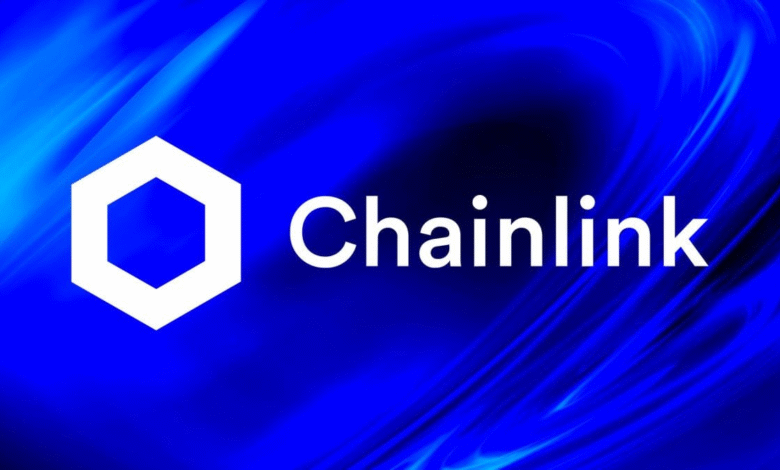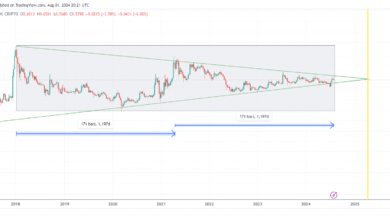Chainlink: The Rising Star in the Multi-Chain Future

Chainlink is rapidly establishing itself as a cornerstone in the evolving blockchain ecosystem, thanks in part to the recent establishment of its Chainlink reserve. This innovative project enhances the role of the LINK token, tightening its supply while amplifying its utility as an oracle solution. As companies like Circle and Stripe venture into dedicated stablecoin Layer-1 blockchains, the relevance of traditional platforms like Ethereum is increasingly scrutinized. In this fragmented landscape, Chainlink benefits enormously by acting as a crucial link among various blockchains, leveraging its extensive partnerships with major financial institutions. With a growing demand for reliable decentralized oracles, Chainlink stands ready to capitalize on the burgeoning need for its services, making it a promising player in the crypto industry.
The emergence of Chainlink highlights a significant shift in the blockchain realm, particularly as it relates to decentralized data services. Known for its ability to bridge real-world information and smart contracts, this project is reiterating the importance of interoperability in a diverse blockchain environment. As Layer-1 chains rise and competition intensifies, alternative protocols like Chainlink continue to solidify their position as essential infrastructure within the network. The recent focus on its LINK token and strategic partnerships showcase how institutional interest is steering the narrative towards a more cohesive, multi-chain future. Consequently, Chainlink’s role as a reliable oracle provider positions it uniquely as demand for blockchain-based solutions escalates.
The Significance of the Chainlink Reserve
The establishment of the Chainlink reserve represents a pivotal moment for the LINK token, considering its potential to bolster demand significantly. By utilizing revenues from both on-chain and off-chain transactions to acquire LINK tokens, the reserve effectively acts as a safety buffer—protecting the asset while creating scarcity in the market. As strategic holdings of LINK tokens accumulate, the implications for the token’s value are profound; reduced supply amidst growing demand could lead to an upward price trajectory. Moreover, with estimates suggesting that purchases could eventually reach the ten-digit mark, the anticipation surrounding LINK’s performance is palpable.
The Chainlink reserve also aligns with the project’s broader strategy to entrench itself within traditional financial systems. By tying revenue directly back into LINK, Chainlink not only enriches its tokenomics but also solidifies its status as a credible player in the decentralized finance landscape. With institutional interest swelling, particularly from large banks and financial institutions, the reserve’s impact could be transformative. It signals a commitment to sustaining the utility of the LINK token amidst an evolving market while simultaneously attracting a wave of new investors who see long-term value in its decentralized infrastructure.
How Blockchain Fragmentation Fuels Chainlink’s Growth
As blockchain technology advances, the emergence of multiple Layer-1 solutions signifies a shift toward increasing fragmentation across the crypto landscape. Companies like Circle and Stripe, who are launching their own independent blockchains, illustrate a trend that could disrupt Ethereum’s dominance as a settlement layer. This fragmentation not only creates new challenges but also paves the way for Chainlink to shine. By providing indispensable oracle services that enable interoperability between various chains, Chainlink is positioned to become an essential infrastructure player, thus enhancing its adoption across diverse networks.
This shift toward blockchain fragmentation means that Chainlink’s role as a decentralized oracle becomes more crucial. As more projects launch their Layer-1 chains, they will inherently require reliable data services to facilitate transactions and ensure security. Chainlink’s existing partnerships and robust infrastructure enable it to cater to these new networks effectively. By serving as a bridge across disparate chains, Chainlink can attract new users and applications, ensuring that it remains at the forefront of not just DeFi but the broader blockchain ecosystem—ultimately positioning LINK as a vital asset in portfolios looking to capitalize on this multi-chain future.
Chainlink: A Pillar in a Fragmented Blockchain Ecosystem
In the current landscape where multiple Layer-1 blockchains are on the rise, Chainlink’s unique proposition as a modular oracle platform solidifies its role as a key infrastructure provider. Chainlink excels at providing essential data feeds and connections that facilitate seamless interactions across various blockchain networks. With its existing deployment across over 60 networks and security for $91 billion in assets, Chainlink demonstrates its effectiveness in the decentralized finance space, thus attracted interest from a variety of traditional financial institutions.
This benefits LINK token holders, as heightened demand for Chainlink’s services results in a self-perpetuating cycle: increased applications lead to greater revenue, which in turn fosters further investment in Link buybacks and development. As the fragmentation of the blockchain world intensifies, the value of Chainlink as a unified layer increases, reinforcing the demand for LINK tokens, which many investors view as a strategic asset in light of the potential risks posed by other cryptocurrency investments.
Institutional Adoption: Chainlink’s Competitive Edge
Chainlink’s partnerships with prestigious institutions like JPMorgan and the Intercontinental Exchange (ICE) showcase its growing legitimacy and institutional traction within the blockchain sector. These collaborations enable Chainlink to offer real-time pricing for Forex and commodities, providing immense value to financial services. In contrast to other crypto projects, where many compete for attention yet lack substantial utility, Chainlink’s focus on producing concrete, actionable solutions lends it a competitive edge in a rapidly evolving market.
As traditional finance embraces blockchain technology, projects like Chainlink stand to gain significantly. Institutional players recognize the need for reliable and accurate data oracles to successfully operate in the crypto economy, which could further push Chainlink’s adoption. This increasing visibility among established financial players not only ensures a robust backing for LINK but also creates a strong narrative around its potential, positioning it as a superior alternative to other cryptos, such as XRP, which currently faces challenges in maintaining market relevance.
Future Prospects for the LINK Token
As Layer-1 blockchains proliferate and the landscape grows more competitive, LINK’s value proposition becomes more compelling. Unlike many Layer-1 tokens that are vying for investor attention, Chainlink benefits from a unique position of being the go-to oracle solution for diverse ecosystems. This reliability is critical, especially in an environment where new blockchains may struggle to establish the required infrastructure for reliable data handling.
Moreover, with the projected increase in utilization of Chainlink’s services over the coming years, the reserve now amplifies both scarcity and demand for LINK token. Investors looking for long-term stability recognize that the projects with strong fundamentals and integration into global finance, like Chainlink, hold significant promise as crypto markets mature. Therefore, for those considering an entry into the cryptocurrency market, LINK stands out as a sound investment choice amidst an uncertain future.
Analyzing Chainlink’s Strategic Partnerships
Chainlink’s impressive portfolio of partnerships illustrates its critical role within the blockchain ecosystem. Collaborations with financial giants allow Chainlink to offer secure and reliable data feeds that traditional and decentralized organizations can leverage, which further entrenches its necessity in the market. This strategy minimizes competitive pressures while maximizing Chainlink’s adoption, reinforcing its relevance as a chosen solution for financial institutions and other enterprises alike.
Furthermore, each partnership enhances Chainlink’s credibility, opening avenues for future collaborations while securing its status as a leader in the oracle sector. As more entities recognize the importance of data accuracy and accessibility in their operations, Chainlink’s established networks will become increasingly invaluable. Investing in LINK is therefore not just a bet on a token but rather on the broader trend towards trust in decentralized data services in finance.
The Role of Chainlink Oracles in DeFi
Chainlink oracles play a vital role in the operation of decentralized finance (DeFi) applications by providing vital price feeds critical for lending, borrowing, and trading protocols. As the DeFi space continues to expand, the demand for reliable and tamper-proof data from oracles like Chainlink will only intensify. This growing reliance emphasizes the importance of Chainlink’s technology, setting it apart from emerging Layer-1 solutions that might not offer the same level of reliability.
The robustness of Chainlink’s oracles ensures that they can adapt to the needs of various DeFi applications, making them indispensable in this burgeoning sector. As more innovative financial products are developed, the need for accurate and timely data will stimulate further adoption of Chainlink’s services, positioning LINK as not just a speculative asset but as an essential component of the DeFi infrastructure.
Why Chainlink Dominates the Oracle Sector
Chainlink’s strategic advantage over other oracle solutions lies in its proven track record of security and reliability. With a significant amount of capital locked within its oracles, Chainlink has established a moat that competitors struggle to breach. This efficacy instills confidence in users and developers, leading them to prefer Chainlink for data services over less established options.
As Layer-1 chains evolve, the demand for robust oracle services will correlate with the increasing complexity of cross-chain interactions. Chainlink’s dominance in this arena makes it a focal point for any blockchain seeking to utilize decentralized data feeds. This interdependency further entrenches the necessity of Chainlink within the crypto landscape, affirming the potential for the LINK token to experience substantial growth as ecosystem demand surges.
Investing in LINK: Considerations for Potential Investors
For investors eyeing the cryptocurrency market, LINK presents not only a compelling investment opportunity but also a strategic position within the broader blockchain ecosystem. Its unique ability to adapt to changes in the market, particularly in response to increased competition and blockchain fragmentation, enhances its attractiveness as a long-term holding. The projected rise in partnerships and demand for oracle solutions underscores LINK’s relevance as an asset in any diversified cryptocurrency portfolio.
Investors should consider the ongoing technological advancements and institutional integrations that Chainlink fosters, as these developments will contribute to its growth and sustainability. While the market can be volatile, the strength of Chainlink’s infrastructure and its pivotal role within the decentralized economy project it as a largely stable investment, particularly appealing as the narrative around blockchain continues to unfold.
Frequently Asked Questions
What is the Chainlink reserve and how does it affect the LINK token?
The Chainlink reserve is a strategic holding established to accumulate LINK tokens using on-chain and off-chain revenues. This reserve aims to strengthen the utility of the LINK token while tightening its supply, ultimately enhancing its value as the demand for Chainlink oracle services increases.
How do Chainlink partnerships influence the value of the LINK token?
Chainlink’s extensive partnerships with major financial institutions like JPMorgan and Swift enhance the credibility and adoption of the LINK token. As these partnerships expand, they drive increased demand for Chainlink’s oracle services, which can significantly boost the value of the LINK token in the crypto market.
What role do Layer-1 blockchains play in the future of Chainlink and its oracle services?
The emergence of dedicated Layer-1 blockchains by firms such as Circle and Stripe is beneficial for Chainlink. As the blockchain ecosystem becomes more fragmented, Chainlink’s oracle services become increasingly essential for bridging these different systems, reinforcing its role as a universal infrastructure layer.
How does Chainlink’s oracle technology enhance cross-chain transactions?
Chainlink’s oracle technology facilitates secure asset transfers across different blockchain networks. By providing real-time data feeds and ensuring reliable communication between various Layer-1 blockchains, Chainlink enhances the efficiency and reliability of cross-chain transactions.
What potential does LINK have in relation to its supply cap?
With a maximum supply of 1 billion LINK tokens and a significant portion already in circulation, the establishment of the Chainlink reserve is expected to create structural demand for the token, possibly driving its price higher as scarcity increases in response to growing demand from institutional partners.
Can Chainlink benefit from the fragmentation of the blockchain ecosystem?
Yes, Chainlink stands to benefit from blockchain fragmentation as its oracle services provide necessary connectivity between disparate systems. As more Layer-1 blockchains emerge, the demand for Chainlink’s infrastructure will likely grow, reinforcing its market position and increasing the value of the LINK token.
How does Chainlink’s revenue model operate in relation to the LINK token?
Chainlink’s revenue model involves generating income from its oracle services, which is then used to buy back LINK tokens and support the newly established reserve. This cycle of revenue generation and token buybacks helps to solidify the value of the LINK token in the market.
What are the implications of institutional adoption for Chainlink and the LINK token?
Institutional adoption of Chainlink’s services, evidenced by collaborations with major firms, is likely to elevate the profile of the LINK token. As demand for on-chain and off-chain data increases, the LINK token could experience significant value appreciation, reflecting its utility in traditional finance.
Why is Chainlink considered a leader in the oracle sector?
Chainlink is recognized as a leader in the oracle sector due to its established network and partnerships, wide adoption across multiple blockchain platforms, and its unique position as an essential infrastructure connector between various blockchain ecosystems.
How does Chainlink address competition from other crypto projects?
Chainlink faces minimal competitive pressure in the oracle space because its comprehensive solution provides unmatched value. While many Layer-1 tokens compete for investor interest, Chainlink’s established role as a data bridge ensures it remains essential in the evolving blockchain landscape.
| Key Point | Details |
|---|---|
| Chainlink Reserve | Chainlink is establishing a reserve of its oracle coins, aiming to tighten supply and increase demand through strategic holdings. |
| Blockchain Fragmentation | New Layer-1 blockchains by major companies like Circle and Stripe are emerging, suggesting a fragmented multi-chain future that may undermine Ethereum’s monetary premium. |
| Chainlink’s Unique Position | Chainlink provides essential infrastructure services across multiple blockchains, ensuring its critical role in a fragmented ecosystem. |
| Institutional Adoption | Chainlink is collaborating with major financial institutions like JPMorgan and ICE, enhancing its credibility and use case. |
| Market Potential | As Layer-1s proliferate and demand for LINK increases, there is potential for significant price appreciation if LINK captures market share similar to XRP. |
Summary
Chainlink is poised for significant growth as it solidifies its position in the evolving blockchain landscape. With the establishment of a reserve to enhance the demand for its token, Chainlink is navigating the challenges posed by the fragmentation of blockchain ecosystems and the rise of Layer-1 platforms. The company’s unique role as a data oracle and its partnerships with financial giants ensure its relevance in future projects, positioning it as a crucial player in the cryptocurrency space. Investing in Chainlink at this pivotal moment could yield promising returns as it continues to bridge the gap between traditional finance and blockchain technology.



